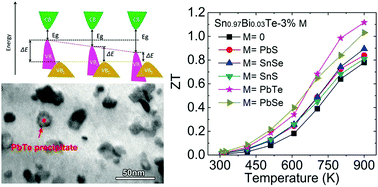当前位置:
X-MOL 学术
›
Energy Environ. Sci.
›
论文详情
Our official English website, www.x-mol.net, welcomes your feedback! (Note: you will need to create a separate account there.)
Simultaneously enhancing the power factor and reducing the thermal conductivity of SnTe via introducing its analogues
Energy & Environmental Science ( IF 32.5 ) Pub Date : 2017-09-29 00:00:00 , DOI: 10.1039/c7ee02530k Xiao Zhang 1, 2, 3, 4 , Dongyang Wang 1, 2, 3, 4 , Haijun Wu 5, 6, 7, 8 , Meijie Yin 4, 9, 10, 11, 12 , Yanling Pei 1, 2, 3, 4 , Shengkai Gong 1, 2, 3, 4 , Li Huang 4, 9, 10, 11, 12 , Stephen J. Pennycook 5, 6, 7, 8 , Jiaqing He 4, 9, 10, 11, 12 , Li-Dong Zhao 1, 2, 3, 4
Energy & Environmental Science ( IF 32.5 ) Pub Date : 2017-09-29 00:00:00 , DOI: 10.1039/c7ee02530k Xiao Zhang 1, 2, 3, 4 , Dongyang Wang 1, 2, 3, 4 , Haijun Wu 5, 6, 7, 8 , Meijie Yin 4, 9, 10, 11, 12 , Yanling Pei 1, 2, 3, 4 , Shengkai Gong 1, 2, 3, 4 , Li Huang 4, 9, 10, 11, 12 , Stephen J. Pennycook 5, 6, 7, 8 , Jiaqing He 4, 9, 10, 11, 12 , Li-Dong Zhao 1, 2, 3, 4
Affiliation

|
Nowadays, extensive endeavors have been made to explore the potential thermoelectric performance of SnTe through either enhancing the power factor or reducing its thermal conductivity. Herein, we report that both the power factor and thermal conductivity of SnTe can be simultaneously improved through introducing its analogues (PbTe, PbSe, PbS, SnSe, and SnS) into the SnTe matrix. We found that the power factor of SnTe could be greatly enhanced over the whole temperature range through modifying its band structure via alloying with its analogues, which is supported by density functional calculations. Meanwhile when the solubility limit of PbTe is exceeded, aberration-corrected scanning transmission electron microscopy observations reveal a hierarchical architecture with multi-scale structural defects, resulting in a very low thermal conductivity through scattering phonons of a wide range of wavelength. The combination of simultaneously enhanced power factor and depressed thermal conductivity leads to a maximum ZT ∼ 1.1 at 900 K and a high average ZT ∼ 0.52 at 300–900 K for Sn0.97Bi0.03Te–3% PbTe, generating a high conversion efficiency of ∼10%. The present results indicate that SnTe is a robust candidate for medium-temperature thermoelectric power generation.
中文翻译:

通过引入其类似物同时提高功率因数并降低SnTe的热导率
如今,已经进行了广泛的努力来通过提高功率因数或降低其热导率来探索SnTe的潜在热电性能。在这里,我们报道通过将其类似物(PbTe,PbSe,PbS,SnSe和SnS)引入SnTe矩阵,可以同时提高SnTe的功率因数和导热系数。我们发现通过改变其能带结构,可以在整个温度范围内大大提高SnTe的功率因数与类似物形成合金,这在密度泛函计算的支持下得以实现。同时,当超过PbTe的溶解度极限时,像差校正的扫描透射电子显微镜观察显示出具有多尺度结构缺陷的分层结构,从而通过散射宽波长范围的声子而导致非常低的热导率。同时增强功率因数的组合和压下的热导率导致的最大ZT在900 K和高平均〜1.1 ZT〜0.52在300-900 K中的Sn 0.97铋0.03Te–3%PbTe,产生约10%的高转换效率。目前的结果表明,SnTe是中温热电发电的可靠选择。
更新日期:2017-11-08
中文翻译:

通过引入其类似物同时提高功率因数并降低SnTe的热导率
如今,已经进行了广泛的努力来通过提高功率因数或降低其热导率来探索SnTe的潜在热电性能。在这里,我们报道通过将其类似物(PbTe,PbSe,PbS,SnSe和SnS)引入SnTe矩阵,可以同时提高SnTe的功率因数和导热系数。我们发现通过改变其能带结构,可以在整个温度范围内大大提高SnTe的功率因数与类似物形成合金,这在密度泛函计算的支持下得以实现。同时,当超过PbTe的溶解度极限时,像差校正的扫描透射电子显微镜观察显示出具有多尺度结构缺陷的分层结构,从而通过散射宽波长范围的声子而导致非常低的热导率。同时增强功率因数的组合和压下的热导率导致的最大ZT在900 K和高平均〜1.1 ZT〜0.52在300-900 K中的Sn 0.97铋0.03Te–3%PbTe,产生约10%的高转换效率。目前的结果表明,SnTe是中温热电发电的可靠选择。


























 京公网安备 11010802027423号
京公网安备 11010802027423号